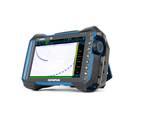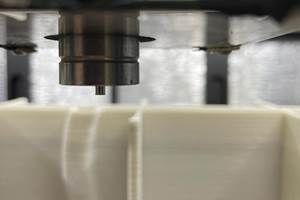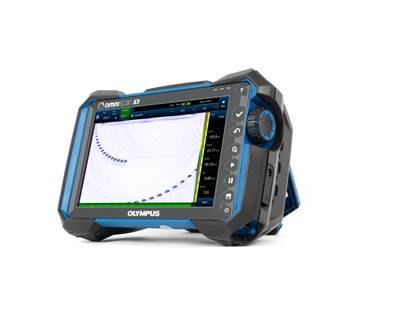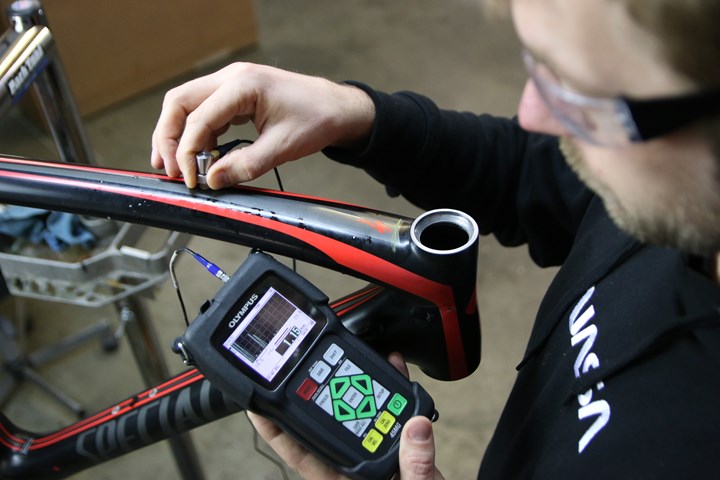
Shawn Small, owner and chief engineer of Ruckus Composites, displays an A-scan reading on the 45MG thickness gage while conducting an ultrasound inspection on a carbon fiber bicycle frame. This reading displays the amount of received ultrasonic energy as a function of time. Source | Olympus
An undetected crack in a carbon fiber bicycle frame or component could present a large catastrophic liability to a cyclist, leading to potential injuries. Despite this, according to carbon fiber inspection and specialty repair shop (Portland, Ore., U.S.), a carbon fiber bicycle frame is one of the best bike investments a cyclist can make, due to the light weight, comfortable design, long life and repairability of carbon fiber bicycles.
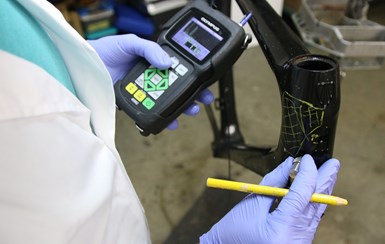
Ruckus Composites’ technicians use an Olympus gage to map out damaged areas of a bike frame. Source | Olympus
Ruckus Composites has evaluated more than 13,000 carbon fiber bicycles and repaired more than 6,000 since it opened in 2008, and also works with professional racing teams and bicycle shops all over the world. About four years ago, the shop’s owner and chief engineer, Shawn Small, invested in an Olympus (Waltham, Mass., U.S.) for high-tech carbon fiber inspection, investigation and quality control. According to Olympus, Ruckus Composites’ inspection and repair process begins with using the Olympus gage for ultrasound scanning and damage mapping.
The nondestructive instrument is used to detect internal delamination; it can “see” the internal structure of the constructed composite material layers of a bicycle frame without the need to physically cut into the frame. According to Olympus, the 45MG ultrasonic thickness gage works by precisely measuring how long it takes for a sound pulse generated by an ultrasonic transducer to travel through one side of a material. In composite materials, sound energy scatters from individual grain boundaries between fibers within the composite. The instrument is said to be able to detect irregular scatter patterns in the material and signals this back to the operator.
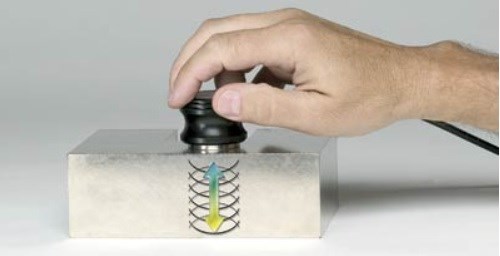
Ultrasound gages work by measuring how long it takes for a sound pulse generated by a small probe (transducer) to travel through a test piece and reflect back from the inside surface or far wall. Source | Olympus
“We push our Olympus 45MG to the limits; the device has paid for itself,” Small says. “The 45MG has become a staple to our daily business services.”
Small adds that after using the gage to map out the damaged areas of the bicycle, Ruckus Composites then designs a tapered composite repair plan. The damaged carbon fiber is machined off of the frame and new carbon fiber is applied based on the team’s layup schedule. The structure is vacuum bagged and oven cured, and then the paint and graphics are restored in-house, Small says.
The Olympus gage, Small says, helps Ruckus Composites ensure the quality of its service based on its ability to show the structural integrity invisible to the human eye, and is a top benefit and helps them ensure quality service. He adds that the 45MG thickness gage is also easy to use and portable.
“It’s shocking how little visible damage the bike could show,” Small says. “We use the 45MG to evaluate the structural integrity of the composite structure. It also allows us to accurately map out our composite repair process. This helps us ensure the quality of our service work. For example, we can scan the bike in an undamaged area for comparison to determine the laminate thickness. We then use this data to inform how much material our lay-up technician needs to apply to the damage area.”
Related Content
CFRP planing head: 50% less mass, 1.5 times faster rotation
Novel, modular design minimizes weight for high-precision cutting tools with faster production speeds.
Read MoreLarge-format AM speeds plug production for manufacture of composite boat molds
Hungarian manufacturer Rapid Prototyping transitioned its conventional foam milling process to 3D printing to produce faster, higher quality, recyclable foam plugs and composite boat molds.
Read MoreMold 3D printing helps automate composite bathtub, shower production
As part of its efforts to automate as much of its production process as it can, Lyons Industries acquired a Massivit 10000 additive manufacturing system to quickly produce high-performance molds and support fixtures.
Read MoreSpanish startup to ramp up production of “recyclable” EV prototype
Liux’s BIG electric vehicle features multiple structural components manufactured via RTM from flax fabric and a thermoset resin said to enable the entire component to be recycled and reused again.
Read MoreRead Next
Flaw detector includes new features to improve inspection workflow
Designed for pressure vessels and pipes, Olympus’s OmniScan X3 flaw detector is said to combine the tools needed for efficient phased array ultrasonic testing (PAUT) inspections.
Read MoreNext-gen fan blades: Hybrid twin RTM, printed sensors, laser shock disassembly
MORPHO project demonstrates blade with 20% faster RTM cure cycle, uses AI-based monitoring for improved maintenance/life cycle management and proves laser shock disassembly for recycling.
Read MoreCeramic matrix composites: Faster, cheaper, higher temperature
New players proliferate, increasing CMC materials and manufacturing capacity, novel processes and automation to meet demand for higher part volumes and performance.
Read More
.jpg;width=70;height=70;mode=crop)
